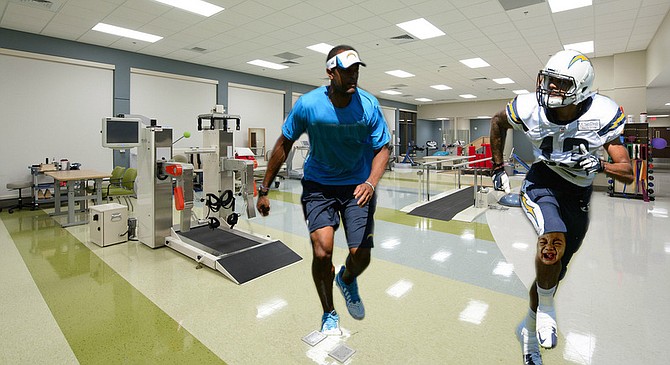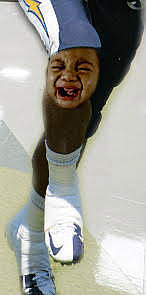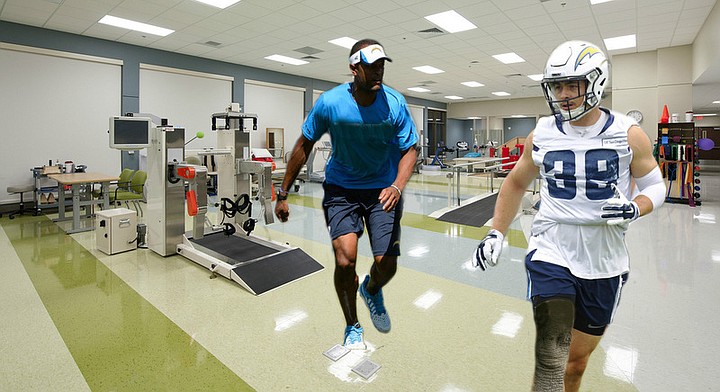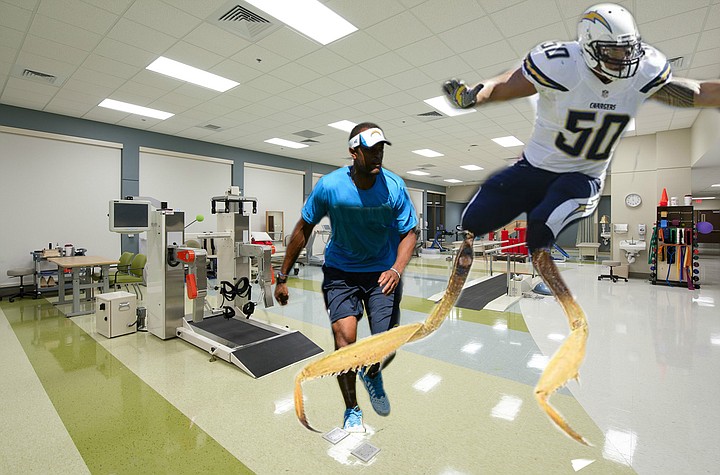 Facebook
Facebook
 X
X
 Instagram
Instagram
 TikTok
TikTok
 Youtube
Youtube

Charger trainer Dr. Isaac Moreau has been a busy man this season — busier than he’d like to be. Game after game has produced injury after injury, some of them season-ending. But he’s not just sitting back and letting nature take its course. Instead, he’s seeking out bold new methods of treatment, right here in our back yard.
"We already knew of two former NFL quarterbacks — the 49ers’ John Brodie and the Packers' Bart Starr — who reported significant physical improvements following stem cell treatments in Tijuana,” explains Moreau. "And we have a company right here in San Diego County, Regenexx, that specializes in using stem cells in the treatment of orthopedic conditions. According to Regenexx, those little buggers can work miracles under the right conditions. The Chargers are big believers in the team’s involvement with local businesses, so we got in touch immediately following Keenan Allen’s crushing injury. They had him in therapy before the end of the day, and by the end of the week, he was walking without pain.

Unfortunately, the world of stem-cell therapy is still pretty much uncharted territory, and there’s a pioneering, experimental character to the whole enterprise. You can’t always predict what’s going to happen when you inject cells from a human embryo into another human person. In this case, we’ve seen the development of what doctors are calling a "weeping knee." Actually, it’s more "crying and screaming" than "weeping." And in the past few days, it’s started getting pretty demanding, always saying that it’s tired and wants a juice break and a cookie. But Keenan has kept a wonderful attitude through it all, and we have high hopes for next season in Los Angeles. I’m sorry: next season, full stop."

“When Danny [Woodhead] pulled up lame,” continues Moreau, "we knew we wanted to avoid the problems we’d run into with Keenan. So we decided to avoid embryonic human stem cells altogether. Especially since there is significant research out there into the possibility of using animal tissue in this kind of therapy. San Francisco’s Stone Clinic has already had some success in replacing damaged ligaments with scaffolding made from genetically modified pig ligament. But of course, we didn’t want a pig. We wanted something a little more powerful. Something that could punch through the line the way Woodhead has always done. Hell, better than he’s always done. The injury rate this year makes it pretty clear that human bodies aren’t built to withstand the punishment of modern professional football. So maybe it’s time to stop relying on purely human bodies. And when you think of charging, what do you think of? That’s right, a rhino. And with rhino embryos, you don’t run into the same kind of ethical concerns as you do with human embryos. Sure, a few people gripe about how rhinos are endangered, but then, so are our playoff chances. Danny is now a figurative and a literal Charger, and he couldn’t be happier."

"For Manti Te’o and his damaged Achilles tendon,” concludes Moreau, "we decided to get really creative, to the point of letting his name inspire our therapeutic decisions. It’s a pretty short step from ‘Manti Te’o’ to ‘Mantis Te’o,’ don’t you think? But of course, it wasn’t just some cutesy word-play that guided our medical decisions. A mantis’s forelegs are insanely quick, which is a pretty key trait for a linebacker, who must weave his way through multiple blockers in order to get to the guy with the ball. And they’re proportionally superstrong: Manti could probably just jump over the opponent’s offensive line at this point. Heck, maybe he will. As soon as he gets walking and running down pat, anyway."


Charger trainer Dr. Isaac Moreau has been a busy man this season — busier than he’d like to be. Game after game has produced injury after injury, some of them season-ending. But he’s not just sitting back and letting nature take its course. Instead, he’s seeking out bold new methods of treatment, right here in our back yard.
"We already knew of two former NFL quarterbacks — the 49ers’ John Brodie and the Packers' Bart Starr — who reported significant physical improvements following stem cell treatments in Tijuana,” explains Moreau. "And we have a company right here in San Diego County, Regenexx, that specializes in using stem cells in the treatment of orthopedic conditions. According to Regenexx, those little buggers can work miracles under the right conditions. The Chargers are big believers in the team’s involvement with local businesses, so we got in touch immediately following Keenan Allen’s crushing injury. They had him in therapy before the end of the day, and by the end of the week, he was walking without pain.

Unfortunately, the world of stem-cell therapy is still pretty much uncharted territory, and there’s a pioneering, experimental character to the whole enterprise. You can’t always predict what’s going to happen when you inject cells from a human embryo into another human person. In this case, we’ve seen the development of what doctors are calling a "weeping knee." Actually, it’s more "crying and screaming" than "weeping." And in the past few days, it’s started getting pretty demanding, always saying that it’s tired and wants a juice break and a cookie. But Keenan has kept a wonderful attitude through it all, and we have high hopes for next season in Los Angeles. I’m sorry: next season, full stop."

“When Danny [Woodhead] pulled up lame,” continues Moreau, "we knew we wanted to avoid the problems we’d run into with Keenan. So we decided to avoid embryonic human stem cells altogether. Especially since there is significant research out there into the possibility of using animal tissue in this kind of therapy. San Francisco’s Stone Clinic has already had some success in replacing damaged ligaments with scaffolding made from genetically modified pig ligament. But of course, we didn’t want a pig. We wanted something a little more powerful. Something that could punch through the line the way Woodhead has always done. Hell, better than he’s always done. The injury rate this year makes it pretty clear that human bodies aren’t built to withstand the punishment of modern professional football. So maybe it’s time to stop relying on purely human bodies. And when you think of charging, what do you think of? That’s right, a rhino. And with rhino embryos, you don’t run into the same kind of ethical concerns as you do with human embryos. Sure, a few people gripe about how rhinos are endangered, but then, so are our playoff chances. Danny is now a figurative and a literal Charger, and he couldn’t be happier."

"For Manti Te’o and his damaged Achilles tendon,” concludes Moreau, "we decided to get really creative, to the point of letting his name inspire our therapeutic decisions. It’s a pretty short step from ‘Manti Te’o’ to ‘Mantis Te’o,’ don’t you think? But of course, it wasn’t just some cutesy word-play that guided our medical decisions. A mantis’s forelegs are insanely quick, which is a pretty key trait for a linebacker, who must weave his way through multiple blockers in order to get to the guy with the ball. And they’re proportionally superstrong: Manti could probably just jump over the opponent’s offensive line at this point. Heck, maybe he will. As soon as he gets walking and running down pat, anyway."
Comments